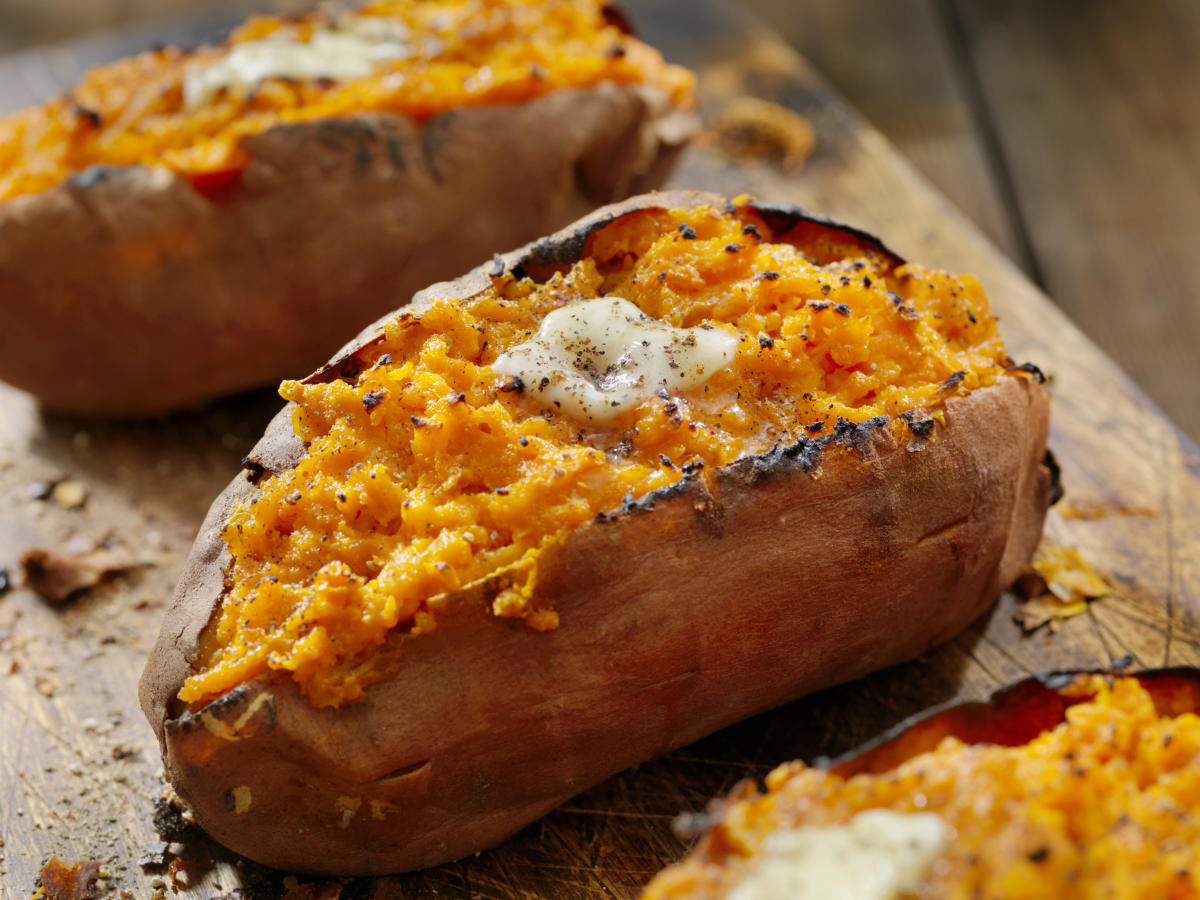Although summer produce often steals the spotlight, the autumn months — September through November — produce a slew of nutrient-dense and delicious fruits and vegetables. As a registered dietitian, I try to encourage people to explore many of these fall-friendly foods and give them a spot on their dinner plates, if they aren’t present already.
Here are five of my favorite autumn fruits and vegetables that not only pack a powerful nutritional punch, but are also delicious and versatile: sweet potatoes, Brussels sprouts, butternut squash, cranberries and pumpkin.
Sweet potatoes
Sweet potatoes are a crowd favorite during the autumn months as their naturally sweet flavor can be used in both savory and sweet dishes. But sweet potato goes far beyond the marshmallow-laden casserole. The vegetable is densely nutritious — about half a cup of sweet potato contains only 80 calories and 486 mg of potassium, which is about 18% of your daily value for women, who should aim to consume about 2,600 mg per day. Potassium is an essential nutrient that works as an electrolyte, maintaining fluid balance in the body. And the American Heart Association has highlighted potassium’s role in managing high blood pressure.
The vegetable may also help maintain healthy blood sugar levels, which may benefit those managing type-2 diabetes.
Sweet potatoes are easy to bake and can be eaten whole or mashed. Sweet potato casserole can also be a healthy choice — just remember to go easy on the butter and consider foregoing the marshmallows on top for optimal nutrition.
Brussels sprouts
It probably comes as no surprise that Brussels sprouts are one of the healthiest vegetables you can eat during the fall season. Brussels sprouts contain only 28 calories, 53% of your daily vitamin C needs and 91% of your daily vitamin K. Vitamin K is an oft-overlooked vitamin that plays an important role in health, including proper blood coagulation and warding off of bone loss as we age.
Brussels sprouts are also a source of antioxidants that help combat cell damage. A half a cup of the vegetable contains 2 grams of fiber, and as most of us aren’t going to eat only half a cup, this can quickly add up to more beneficial fiber.
One easy way to work Brussels sprouts into your diet is by roasting them. Simply toss halved Brussels sprouts with olive oil, salt and pepper, then roast them until they’re crispy on the outside and tender on the inside. You can also toss them into salads, stir-fries or pasta dishes for an extra dose of nutrients and flavor. Another option is to sauté them with garlic and lemon for a quick and tasty side dish that compliments any main course.
Butternut squash
Even if you’re not a fan of yellow summer squash, autumn’s butternut squash is a crowd favorite thanks to its sweeter taste that contains distinct hints of caramel. One cup of butternut squash has only 63 calories, yet it contains 745 micrograms of vitamin A — that’s about 46% of your daily vitamin A needs (based on the Dietary Guidelines recommendation of 1,600 mcg per day for women 18 years and older). Vitamin A plays a role in maintaining healthy vision, supporting immune function and promoting skin health.
One study showed that women in China who ate yellow-orange veggies experienced a decline in cardiovascular risk indicators, meaning that yellow squash may be directly linked to a healthy heart.
Some easy ways to enjoy this versatile vegetable include roasting, blending it into soups and adding it to pasta dishes. You can also incorporate cooked and cooled butternut squash into your smoothie for added creaminess and a boost of vitamins without altering the flavor significantly.
Cranberries
Cranberries aren’t just for juice — they’re a deliciously tart berry that can be used in a variety of ways. Cranberries are a low-calorie fruit with only 46 calories per cup, and they’re actually made up of 87% water. Most people are familiar with the fact that cranberries are powerhouses when it comes to urinary tract health. They contain what is known as A-type proanthocyanidins, a compound found in cranberries that can help both prevent and treat urinary tract infections.
The berries also contain what are known as flavonol polyphenols, which may aid in a slew of health outcomes, including the management of diabetes and cardiovascular disease. Notably, cranberries contain most of these flavonol polyphenols in the skin, so you won’t receive as much of these antioxidants in cranberry juice.
Whole, raw cranberries can be baked into bread, mixed into smoothies, diluted into jams and even used as a garnish for your favorite holiday mocktail. These berries tend to be tart, so eating them with other fruits or with savory meats or bread can help cut down on the tartness.
Pumpkin
Pumpkin isn’t just for Halloween decorations or an ingredient that livens up your fall latte — pumpkin is a nutrient-packed, versatile fruit that can be added to just about any savory or sweet recipe. Pumpkin puree is low in calories at only 83 calories per cup, and each serving provides a whopping 245% of your daily vitamin A needs. Vitamin A directly aids in healthy thyroid and metabolic functions, which may help support weight management.
Additionally, pumpkin contains prebiotic fiber, which can help support gut health.
To enjoy this nutritious gourd, try stirring a few tablespoons of pumpkin puree into your morning oatmeal and topping it with nuts and maple syrup for added flavor and nutrition. You can also whip up a batch of pumpkin pancakes: Add pumpkin puree and spices to your pancake batter for a seasonal twist on breakfast.
Lauren Manaker is a dietitian and author.














